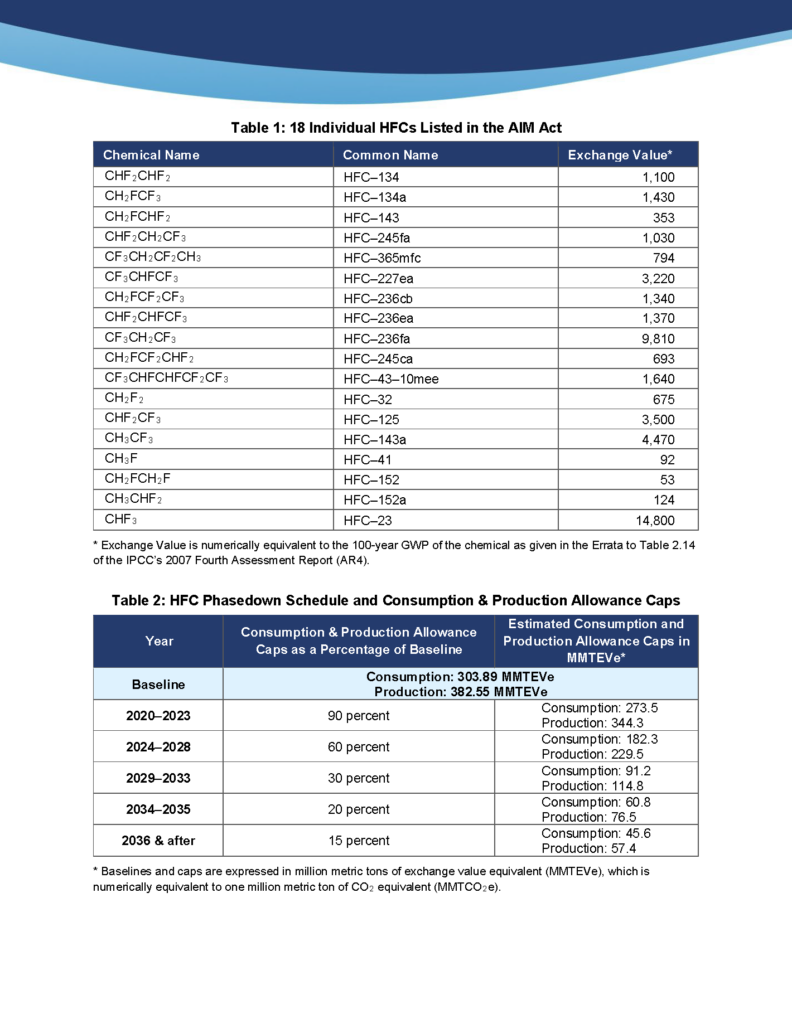FACT SHEET
Final Rule – Phasedown of Hydrofluorocarbons: Establishing the Allowance Allocation and Trading Program under the American Innovation and Manufacturing (AIM) Act
What is the AIM Act and this Final Rule?
Congress enacted the American Innovation and Manufacturing (AIM) Act on December 27, 2020. The AIM Act provides new authority for the U.S. Environmental Protection Agency (EPA) to address hydrofluorocarbons (HFCs) in three ways: (1) phasing down production and consumption, (2) maximizing reclamation and minimizing releases from equipment, and (3) facilitating the transition to next-generation technologies through sector-based restrictions. This final rule focuses on the first area – the phasedown of HFC production and consumption.
What is the HFC Phasedown?
The AIM Act directs the EPA to phase down HFC production and consumption (see Table 1) by 85% below baseline levels by 2036 through an allowance allocation and trading program. EPA has established U.S. production and consumption baselines using a formula provided by the AIM Act that considers past HFC, hydrochlorofluorocarbon (HCFC), and chlorofluorocarbon
(CFC) amounts.2 By October 1 of each year, EPA must issue production and consumption allowances relative to those baselines for the following calendar year. The maximum number of allowances that the EPA may allocate per year is shown in Table 2.
About Hydrofluorocarbons (HFCs)
HFCs are potent greenhouse gases (GHGs) developed and manufactured to replace ozone-depleting substances (ODS) in refrigeration, air conditioning, aerosols, fire suppression, and foam-blowing sectors. These fluorinated chemicals have no known natural sources. They have global warming potentials (GWPs) (a measure of the relative climatic impact of a GHG) that can be hundreds to thousands of times greater than carbon dioxide (CO2). HFC use is growing worldwide due to the phaseout of ODS and the increasing use of refrigeration and air-conditioning equipment globally.

Who is Affected by this Final Rule?
Companies that produce, import, export, destroy, use as a feedstock, reclaim, package, or otherwise distribute HFCs may be affected by the final rule. Companies may also be affected if they use HFCs to manufacture refrigeration and air-conditioning equipment, foams, aerosols, and fire suppressants or use HFCs in one of the six applications specified in the AIM Act.3
What are the Costs and Benefits of this Final Rule?
American consumers are expected to benefit from transitioning from HFCs to environmentally safer alternatives and more energy-efficient cooling technologies.
EPA estimates that the present value of the cumulative net benefits of this action is $272.7 billion from 2022 through 2050. In 2036 alone, the year the final reduction step is made, this rule is expected to prevent 171 MMTCO2e emissions – roughly equal to the annual GHG emissions from one out of every seven-passenger vehicles registered in the United States.
EPA conducted an environmental justice analysis that determined overall reductions in GHG emissions from this rule will benefit populations that may be especially vulnerable to damages associated with climate change, such as the very young, elderly, economically disadvantaged, disabled, and indigenous populations.
What are the Key Provisions of the Final Rule?
To implement the allowance allocation and trading program, EPA has:
- Established the HFC production and consumption baselines from which reductions must be made according to the formulas provided in the AIM Act.
- Codified the phasedown schedule (as shown in Table 2).
- Established an initial methodology for issuing allowances for 2022 and 2023 that:
- Issues allowances to companies that produced and/or imported HFCs in 2020 based on the three highest non-consecutive years of production or import between 2011 and 2019.
- Issues “application-specific allowances” directly to entities within the six applications listed in the AIM Act. These entities can confer their allowances to producers or importers to acquire needed HFCs.
- Set aside some allowances for application-specific end users and small importers only identified after the public comment period ends and new market entrants.
- Establishing a methodology for trading allowances between companies while requiring an offset of allowances to benefit the environment further. The offset is 5% of the amount transferred and is reduced from the transferor’s allowance balance.
To ensure compliance with the phasedown limits, this final rule:
- Establishes an electronic tracking system for the movement of HFCs through commerce;
- Requires the use of refillable cylinders and container labeling requirements;
- Establishes administrative consequences (e.g., revocation or retirement of allowances) for noncompliance that would be in addition to any civil and criminal enforcement action;
- Requires third-party auditing of companies’ recordkeeping and reporting; and
- Provides transparency of HFC production and consumption data for the general public and participants in the market, and supports enforcement and compliance efforts.



